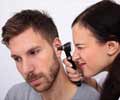The American Academy of Otolaryngology-Head and Neck Surgery Foundation published a new Clinical Practice Guideline on Sudden Hearing Loss (SHL).

The purpose of this guideline is to provide all clinicians who may encounter patients with SHL with evidence-based recommendations for diagnosis, counseling, treatment, and follow-up. By focusing on opportunities for quality improvement, the guideline should improve diagnostic accuracy, facilitate prompt intervention, decrease variations in management, reduce unnecessary tests and imaging procedures, and improve hearing and rehabilitative outcomes for affected patients.
"We are pleased that this guideline provides doctors with a set of evidence-based recommendations for patients who present with sudden hearing loss. This guideline will help advance the care of afflicted patients and result in improved outcomes," said Robert J. Stachler, MD, Guideline Chair.
Key Points for the AAO-HNSF Clinical Practice Guideline: Sudden Hearing Loss
What is sudden hearing loss and why is it important? Sudden hearing loss (SHL) is a frightening symptom that often prompts an urgent or emergent visit to a physician. The guideline primarily focuses on sudden sensorineural hearing loss (SSNHL) in adult patients (aged 18 and over).
The panel recognized that patients enter the health care system with SHL as a nonspecific, primary complaint. Therefore, the initial recommendations of the guideline deal with efficiently distinguishing SSNHL from other causes of SHL at the time of presentation. Prompt recognition and management of SSNHL may improve hearing recovery and patient quality of life (QOL). SSNHL affects 5 to 20 per 100,000 population, with about 4,000 new cases per year in the United States.
Advertisement
What is the purpose of the sudden hearing loss guideline? To provide clinicians with evidence-based recommendations for the diagnosis, management, and follow-up of patients who present with SHL. The guideline is intended for all clinicians who diagnose or manage adult patients (18 and over) who present with SHL. The guideline was developed by a multidisciplinary panel representing the fields of otolaryngology, otology, neurotology, neurology, family medicine, emergency medicine, audiology, nurse practitioners, and consumer advocacy groups.
Advertisement
- Prompt and accurate diagnosis is important:
a. Sensorineural ('nerve') hearing loss should be distinguished clinically from conductive ('mechanical') hearing loss.
b. Unusual presentations such as bilateral SSNHL, recurrent SSNHL, or focal neurological findings (problem with nerve, spinal cord, or brain function) may represent definable underlying disease and should be managed accordingly.
c. The diagnosis of idiopathic sudden sensorineural hearing loss (ISSNHL), is made when audiometry confirms a 30 decibel hearing loss at three consecutive frequencies and an underlying condition cannot be identified by history and physical exam. - Unnecessary tests and treatments should be avoided:
a. Routine head/brain CT scans, often ordered in the ER setting, are not helpful and expose the patient to ionizing radiation.
b. Routine, non-targeted, laboratory testing is not recommended.
c. The following should not be routinely prescribed: antivirals, thrombolytics, vasodilators, vasoactive substances, or antioxidants to patients with ISSNHL. - Retrocochlear workup should be performed in all patients with ISSNHL, regardless of hearing recovery.
- Initial therapy for ISSNHL may include corticosteroids.
a. Corticosteroids may be delivered systemically or via intratympanic application.
b. Hyperbaric oxygen, currently not FDA-approved for this indication, may be offered. - Doctors should offer intratympanic steroid perfusion when patients have incomplete recovery from ISSNHL after failure of initial management.
- Follow-up and counseling is important:
a. Doctors should educate patients with ISSNHL about the natural history of the condition, the benefits and risks of medical interventions, and the limitations of existing evidence regarding efficacy.
b. Doctors should obtain follow-up audiometry within six months of diagnosis for patients with ISSNHL.
c. Doctors should counsel patients with incomplete hearing recovery about the possible benefits of amplification and hearing assistive technology and other supportive measures.
Source-Eurekalert










